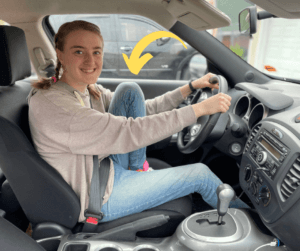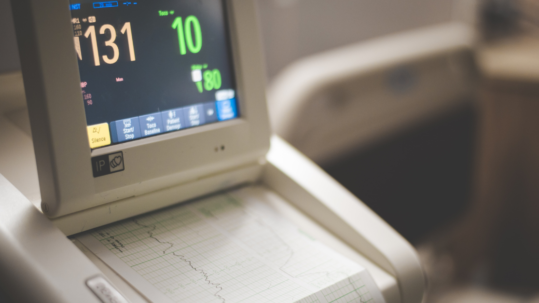
04 Jun Can You Drive With POTS?
Driving is just sitting, so it’s fine – right? It’s a hard question to actually acknowledge for someone doing their best to live a normal life despite having postural orthostatic tachycardia syndrome (POTS).
The condition primarily impacts women between the ages of 15-25, and certainly, there’s a lot at stake. Whether it is retrieving basic necessities like groceries, getting to/from a place of employment (or school!), or staying involved in community, driving can be a critical piece to living an independent life. While most people don’t need to think about the automatic functions of the body (like heart rate, blood pressure, digestion, pupil dilation, etc.), people with POTS are constantly navigating hiccups in these processes along with their daily life. Some trademark symptoms that can impact driving include tachycardia (excessive heart rate), lightheadedness and passing out, fatigue, light sensitivity, blurred vision, and others. While none of these symptoms are ideal, the main advantage is that the majority of symptoms are dependant on changes in posture, like laying to sitting or sitting to standing, and thankfully, driving is just one static position (although that too, can become a problem after long periods of time).
I have experienced seasons of driving as a reasonable and healthy part of my lifestyle with POTS, but I’ve also had weeks and months when I have stopped driving for the safety of myself and those around me. Below, I’ll touch on some tips to stay safe while managing symptoms, and we’ll also talk about when driving needs to be reconsidered.
Safe Driving With POTS
They say an ounce of prevention is worth a pound of cure, and I think it applies here. POTS is a fluctuating condition, meaning not every moment of every day will bring the same challenges. Weather, hydration level, day of the week, sleep patterns, mental health status, and so many more variables all play into a person’s daily ability and limitations. Because of this, it is a GREAT idea to be ahead of the game and set yourself up for success by ensuring that the easily-controlled risk factors are being taken care of both before, and during, your trip. Here are my tips.
Maximize blood volume.
In order for blood to be flowing to the top half of the body, there are a lot of things working together in the circulatory system. Assuming you’re not laying on a perfectly level surface, you have chemicals flowing to the heart letting it know how fast to pump blood to compensate for gravity, you have blood vessels in the legs that need to be responsive to the cues for letting more/less constriction so that the blood doesn’t start pooling (and that also have to be structurally sound enough to get the blood back up to the top, for the EDS folks out there), you have kidneys managing the amount of water you retain, which impacts the volume of blood in the body, and about a million other mini processes. POTS wreaks havoc on this delicately balanced system, and has origins that are still being researched. In the meantime, our main focus is compensation, in an effort to avoid lightheadedness, dizziness, and passing out behind the wheel.
A workaround to this problem is to manipulate our own blood volume, and thereby increase the chances that there will be enough blood circulating to, say, the brain. We can work with the kidneys to accomplish this by drinking water and eating salt, or drinking an electrolyte drink that already balances the water and sodium (and other minerals) that the body needs to efficiently absorb the liquid. Drinking water and electrolytes are cornerstone habits to implement if you have POTS, but it’s especially critical before, and even while, driving.
Use counter-maneuvers.

Again, many symptoms stem from too much blood hanging out in the lower half of the body (thanks to gravity), and not enough getting to the upper half (thanks to floppy blood vessels). A fascinating way to get blood upwards is by doing what they call “counter-maneuvers.”
Essentially, by squeezing or tensing certain muscles we can manually/mechanically force blood upward. This is often recommended to Potsies standing in line (squeezing their calves and such), but also has value in the car. I found that hoisting my left leg up onto my seat was an easy and effective way to fight off symptoms. Not only is the leg tensing (and therefore helping squeeze blood up to the heart/brain), but it is also being elevated to a level closer to the heart, making it easier to be pumped. This is a great one for mild symptoms, and yes, it has a noticeable impact. Here’s a picture of what I mean.
Stay self-aware.
A large part of living with POTS is having the self-awareness to navigate symptoms without lasting consequences. In driving, it is important to check in with yourself frequently to assess if anything needs to change. The top two ways I see this matter is upon first getting in the car, and then also while driving. When I first jump in the car, I typically feel on edge and shaky. I have likely just walked across a parking lot, have done some stairs to get to where I needed to go, or am carrying something heavy, and my pulse is usually well over 100 bpm. So before I turn the key and get on the road I like to pause and let myself get regulated. It may not be possible all the time, but I shoot for a steady pulse below 100 bpm before I start driving. Sometimes I recline in my seat and take slow, deep breaths, and other times it only takes a minute or two of sitting to get recalibrated. From there, I start driving but will frequently check in with myself to make sure all is well.
Have a plan.
Symptoms don’t always abide by the standard MO, so having a backup plan for certain boundaries/symptoms is a smart idea. If sudden lightheadedness or impaired vision comes on, I’ve already made the commitment to myself to pull over, even if I’m running late. From there I would hydrate (and have some salt), employ counter-maneuvers, and recline my seat for a few minutes if needed. Certainly, arriving late is better than never arriving, or injuring others on the way. Additionally, I have reached out to people in certain places around my city, and know that if I’m ever in need, I can call them. This has created significant peace of mind, and there have been two occasions in which I called someone to pick me up from a store or street when I had a sudden onset of symptoms and was uncomfortable in my ability to drive safely.
When To Pause
If you have POTS, you are likely already frustrated at all the limitations. The fatigue is hard enough to chisel your way through each day, the tachycardia is taxing enough to cause frequent disruptions, and the lightheadedness is frustratingly restrictive in doing up-and-down activities (even for things so mundane as putting your shoes on). Realistically, choosing to stop driving sucks. For me, I found that it was a decision that came with grief as I acknowledged the loss of my independence and ability, after months of doing all I could to stay living on my own. It was the rubber-meets-the-road moment of realizing I could not safely keep living as if nothing had changed.
I’m not saying every Potsy has to give up driving, but it is a decision that needs to be thought about if you’re experiencing significant lightheadedness while seated, or if you are experiencing full syncope (passing out).
The Wisconsin DMV website states, “A person cannot drive for 3 months after any episode of altered consciousness or loss of bodily control caused by a neurological condition, and there are no exceptions to this rule.” Many states have similar rules, some even extending it to six months of no driving after passing out.
And just like no text is worth accidentally taking a life, neither is pride, convenience, or denial. Whether it’s your own safety or the safety of the person on the other side of the line, losing consciousness at the wheel can be devastating.
That is why a comprehensive look at symptoms, symptom triggers, and the effectiveness of prevention tools is critical to the discussion on driving with POTS, and why it is so important to be self-aware through the different seasons. If you’re noticing that you are uncomfortable with your level of symptoms behind the wheel, it’s time to take a look at alternatives to driving that you can implement, even if it’s just for a week or a month while you keep working towards stability and recovery.
Living Life Without Driving
There are several things to consider when formulating a plan for getting around without driving yourself. Can it get complicated? Yes. Is it worth it? Also yes.
Carpool.
This is the most convenient option and has been a critical part of my own journey. I was grateful to have a roommate with a similar schedule to myself, and to have others living nearby who attended the same gatherings or events that I regularly attended. Coworkers with the same shift, peers who go to the same school, or neighbors who go to the same church are options to be explored.
Public Transportation.
An obvious option, but finding bus routes and familiarizing yourself with local taxis/uber/lyft businesses is a way to get around, especially in bigger cities.
Miscellaneous transportation options.
I found that my insurance provides free non-emergency medical transportation. That means I have access to rides to/from not only my doctor appointments but also my weekly counseling appointments that are covered by insurance. If you’re in school/university, you may have access to regularly timed bus routes, or there may be transportation offered by the campus for particular circumstances. Working and doing school from home could also be an option, either temporarily or long-term, depending on your needs.
Family and Friends.
The reality is, life with POTS can’t always be done alone. In fact, I don’t think it ever CAN be done alone. Learning to ask for help is a necessity, even when it inconveniences others. Oftentimes I think we are quick to lavish help on those who need it, yet we struggle greatly in asking for it ourselves. Helping the people around us builds community, strengthens relationships, and can hold unexpected blessing for both parties.
There was one day I landed in the ER but had an early morning appointment the next day that I couldn’t miss. After significant hemming and hawing, I reached out to someone from my life group to see if they would be willing to drive me the hour each way. Even though I felt terrible for the early morning, the hours of driving, and the inconvenience, I was quickly engaged in meaningful conversation that I would not have otherwise been able to have. It is safe to say we both walked away blessed that day, and it helped me realize that my limits are a beautiful opportunity for God to move. I was later reading in Luke, and it caught my eye when Jesus was telling parables and explaining how the kingdom of God works. He says, “But when you give a feast, invite the poor, the crippled, the lame, the blind, and then you will be blessed, because they cannot repay you. For you will be repaid at the resurrection of the just” (Luke 13:13-14). My friend welcomed me with open arms even though I couldn’t have done the same for them, and there is a beautiful reward for their kindness that goes beyond anything we may perceive.

Conclusion
There are lots of variables that should be considered when driving with POTS. There are several great ways to set yourself up for success, and each person will have their own rhythm for how they most safely navigate the roads. But as people with a condition known to cause loss of consciousness (or near loss), we also need to be mindful of our limits, and the safety of everyone on the road. There is a time and place when the right thing to do is to stop driving. And that time is before an accident happens, and the place is wherever you are when the decision needs to be made.
I hope this article helps bring clarity and opens the conversation for others to share their experience with making lifestyle decisions in the midst of chronic illness.
-
Making a Full Physical Recovery – A Day-by-Day Miracle
“You should exercise more.” A brutal statement. One I had tried to fulfill on my own, and time and time again, had failed. It was a frustrating piece of advice from my doctor, and felt so out of reach as I navigated my bouquet of chronic illnesses....
27 June, 2024 No comment -
Awesome Recovery News!! And Why I No Longer Plan To Write About My Symptoms
I am so excited to report that after graduating from the 3-week Pain/Symptom Rehabilitation Center at Mayo Clinic in Rochester and continuing the program at home, I am nearly 100% recovered!...
05 March, 2024 3 Comments -
What is the Valsalva Maneuver like?
The Valsalva maneuver is EASILY the most fascinating thing I’ve gotten to do in this entire medical adventure. On the surface, it’s a fairly quick and easy part of autonomic testing, but underneath, it’s one of the coolest and most complicated mechanisms of the human body that I’ve encountered. ...
17 January, 2024 3 Comments






Pingback:What If I'm Faking It - Living With an Invisible Disability - Kaley Faith
Posted at 22:53h, 04 June[…] are times when I am struggling so much I wonder if I’ll ever drive again. I wonder if I’ll ever cook a meal again. I spend 24 hours straight laying in my bed with […]